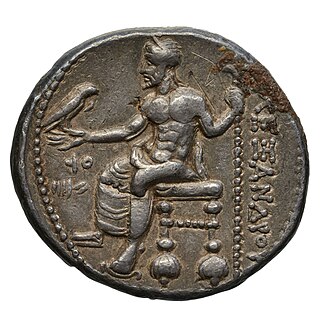Aprus or Apros, also Apri or Aproi (Ἄπροι), was a town of ancient Thrace and, later, a Roman city established in the Roman province of Europa.
Gratianopolis was an ancient city and Roman Catholic diocese in Mauretania Caesariensis in present-day Algeria. It was one of several towns named after the Roman emperor Gratian, and is only known from mentions in church council minutes. Its history, location and present condition are unknown. The name survives as a Roman Catholic titular see, and since 1911 has been the title of the Greek Catholic Apostolic Exarchate.

Ermenek is a town in Karaman Province in the Mediterranean region of Turkey. It is the seat of Ermenek District. Its population is 11,629 (2022). As ancient Germanicopolis, a former bishopric, it remains a Latin Catholic titular see.

Olba or Olbe was an ancient city and bishopric in the Roman province of Isauria, in present-day southern Turkey. It is included in the Catholic Church's list of Latin titular sees.
Germanicopolis was an ancient town in Bithynia, also known as Caesarea in Bythinia (not to be confused with Caesarea Germanica, as such a former bishopric and present Latin Catholic titular see.

The Roman Catholic Archdiocese of Santarém is a Latin Church metropolitan archdiocese in northern Brazil. It was a suffragan diocese in the ecclesiastical province of Belém do Pará until 6 November 2019.
The Roman Catholic Diocese of Suacia was a bishopric with see in the town of Svač, which is today the village lying to the east of Ulcinj in Montenegro that is called in Serbian Шас, in Croat Šas and in Albanian Shas.

Arsuz is a municipality and district of Hatay Province, Turkey. Its area is 462 km2, and its population is 101,233 (2022). It covers the southwestern part of the agglomeration of İskenderun and the adjacent countryside and coast. In ancient times, it was known as Rhosus and was a former bishopric and titular see.

Ptolemais was an ancient port city on the Canaanite coast in the ancient region of Phoenicia, in the location of the present-day city of Acre, Israel. It was also called Ptolemais in Canaan and Ake-Ptolemais. It was an ancient bishopric that became a double Catholic titular see.
The Roman Catholic Diocese of La Canea or Cidonia was a bishopric on Crete, with see at present Chania, and afterward was twice a Latin titular see.
The Roman Catholic Archdiocese of Ohrid was a Latin Catholic archdiocese, suppressed in the 1700s, and is now a titular see, at modern Ohrid in North Macedonia.
The Diocese of Drivasto or Diocese of Drivast was a Roman Catholic bishopric with see in the town of Drivasto from circa 400 to 1650 and is now a Latin Catholic titular see. It was suppressed in 1650 but restored as Latin titular see.

Thiava was an ancient Roman-Berber civitas in Numidia, Africa Proconsulare and in the Vandal Kingdom. It was a Latin Catholic diocese.

Castra Nova was a Roman-era city and diocese in Mauretania, Africa Proconsulare. The town is identified with the stone ruins at Mohammadia, Mascara in modern Algeria. It is now a Roman Catholic titular see.

Thucca in Numidia was an Ancient Roman era town and the seat of an ancient Bishopric during the Roman Empire, which remains only as a Latin Catholic titular see.
Boreum was a city and diocese in Roman Libya. It is now a Roman Catholic titular see.
Tigamibena was an ancient city and bishopric in Roman Mauretania.
Octava was a city and bishopric in Numidia. It is a Roman Catholic titular see.
Sebela was an Ancient city and bishopric in Asia Minor and remains a Latin Catholic titular see.
Vegesela (in Numidia) was an ancient city and former episcopal see in Roman North Africa and remains a Latin Church titular see of the Catholic Church.









